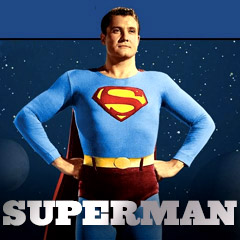
|
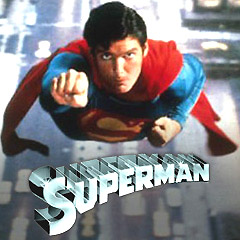
|
|
(chronological by time period and film title) Introduction | Flash Gordon | Buck Rogers | Superman | Batman | Spider-Man | X-Men Marvel Cinematic Universe | The DC Extended Universe Iron Man | Hulk | Thor | Captain America | The Avengers | Guardians of the Galaxy Others: A - F | Others: G - N | Others: O - Z |
(chronological by time period and film title) |
|||||||||||
Superman (The Man of Steel) - was based upon the DC Action Comics' Superman comic-book character created by artist Joe Shuster and writer Jerry (Jerome) Siegel, debuting in Action Comics # 1 (June of 1938). [Note: This particular comic-book issue has become the most valuable one in existence.] Action Comics # 1 contained a detailed account of the origins of Superman on page 1. Krypton wasn't mentioned by name - Superman's place of origin was specified as from a 'distant planet...destroyed by old age,' from which a scientist sent his infant son to Earth in a hastily-devised space-ship. Infant Superman's space-ship was discovered by a motorist (no mention of Jonathan or Martha Kent), and the boy was delivered to an orphanage. Superman's maturity led to tremendous super-powers - he couldn't fly, but he could 'leap' and 'hurdle' over a twenty-story building, raise tremendous weights, and run faster than an express train. "Nothing less than a bursting shell could penetrate his skin" - his invulnerability. The strip proved so popular that Superman was provided with his own self-titled comic book, the first for any superhero, premiering with Superman # 1 (cover date of June 1939), issued monthly. Many more details about Superman's origin and powers were included. Eventually in later issues, Superman was described as having X-Ray vision, the ability to fly, and super-strength.
There was also a regular daily Superman newspaper comic strip that ran for 28 years (from 1939-1967). It began on January 16, 1939, and a separate Sunday strip was added on November 5, 1939. Both strips ran until May of 1966.
Next came a radio series from 1940 to 1951 (the first voice of Superman was Bud Collyer) titled The Adventures of Superman. The first syndicated radio show was broadcast on on February 12, 1940. Superman
was the world's first comic-book superhero to appear on the big screen.
Superman began its successful run with comic books, then radio, and
then films (animated, serials, feature films, and TV series). |
|||||||||||
| Super-Hero Films | |||||||||||
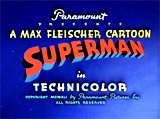 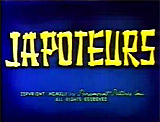
|
Superman (1941-1943) - the Fleischer Animated Cartoons Superman's first film appearance was in an animated series of seventeen Superman Technicolored cartoons released by Paramount Pictures, beginning with Fleischer Studios' creations from 1941-1942, in an agreement with DC Comics. Dave and Max Fleischer were responsible for the first nine Superman cartoons (the pilot and eight subsequent shorts) through Terror on the Midway (1942). The first Superman short, Superman (1941) (aka The Mad Scientist), which premiered in late September of 1941, introduced the terms "faster than a speeding bullet" and "Look, up in the sky!" The most famous of the series was the second entry, The Mechanical Monsters (1941) with the super-hero battling giant flying robots - and marking a redesigned Lois Lane and the first time Superman would change into his costume in a phone booth (and his sole use of X-ray vision in the series). Also notable was the 8-minute short The Bulleteers (1942).
The remaining eight shorts were produced by Paramount's Famous Studios during 1942-1943. [Note: In 1942, Fleischer Studios was dissolved and reorganized as Famous Studios, which produced the final eight shorts.] The shorts began with Japoteurs (1942), and ended with Secret Agent (1943).
|
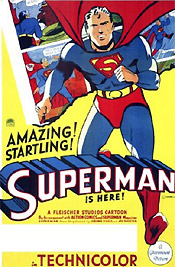
|
|||||||||
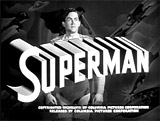
|
Superman (1948) - Theatrical Serial A 15-chapter, black-and-white action serial from Columbia Pictures (directed by Thomas Carr and Spencer Gordon Bennet), with Kirk Alyn as the Kryptonite hero, and Noel Neill as Lois Lane. It marked the very first live-action portrayal or appearance of Superman on film. At one time, it was the most successful serial of all-time. With crude animated flying sequences.
|
 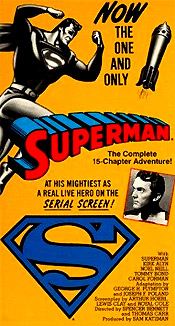
|
|||||||||
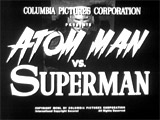
|
Atom Man vs. Superman (1950) - Theatrical Serial A 15-chapter, black-and-white serial-sequel from Columbia Pictures (again directed by Bennet), the studio's 43rd serial. It was about Superman/Clark Kent (Kirk Alyn) fighting against bald Lex Luthor/Atom Man (Lyle Talbot), who threatened Metropolis with a sonic vibrator and crippled the "Man of Steel" with kryptonite. Other characters included Lois Lane (Noel Neill), Jimmy Olsen (Tommy Bond), and Daily Planet editor Perry White (Pierre Watkin). This marked the second live-action appearance of Superman on film. On one of the film's posters, it advertised: "Based on the SUPERMAN adventure feature appearing in SUPERMAN and ACTION COMICS magazines and in daily and Sunday newspapers coast to coast, Adapted from the SUPERMAN radio program."
|
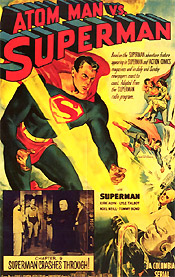
|
|||||||||
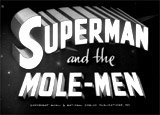
|
Superman and the Mole-Men (1951) Notable as the first full-length Superman theatrical non-serial feature film (at 58 minutes in length) based on the DC Comics super-hero character. It starred George Reeves as Superman (rather than Kirk Alyn, who reportedly wanted too much money), and Phyllis Coates as Lois Lane. The black and white film was an attempt by the comics publisher to encourage interest in having the Superman character appear on TV, which would occur a year later. It was the basis for the syndicated Adventures of Superman TV series (see below). Over a year after its release, the 1951 film was split up (or re-edited) and aired as a "two-parter" episode entitled "The Unknown People" to close the first season (1952) of the early 50s TV show, Adventures of Superman (see below). |
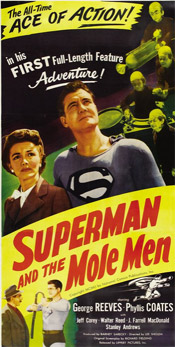
|
|||||||||
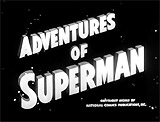 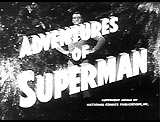 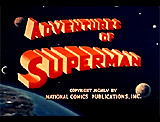 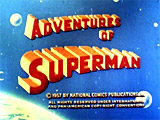
|
Adventures of Superman (1952-1958) - TV series This was the popular, syndicated TV series from 1952-1958 (with a total of 104 30-minute episodes) that again starred George Reeves and Phyllis Coates, and was a carry-over from the 1951 movie. It was the first network TV series to feature super-hero Superman. The superhero was described in the opening sequence:
The first two seasons had 26 episodes, while the remaining four seasons had 13 episodes each.
The first two seasons were in black and white, and although the remaining four seasons of the series (1955-1958) were filmed in color, they were not telecast in color. The 1951 film, Superman and the Mole Men (1951), was split into two, and broadcast in two episodes, as the last two segments of the first season of the show. Those episodes (#25 and 26) were a two-parter titled The Unknown People. Note: A number of black and white episodes from 1953 were pieced together and distributed as five feature films in 1954 for release by 20th Century Fox:
|
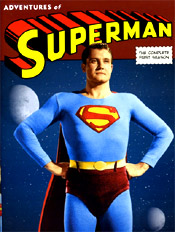
|
|||||||||
|
The New Adventures of Superman (1966-1970) - TV series This was a series of six-minute animated Superman adventures (68 segments or cartoons in total) produced by Filmation that were broadcast on CBS-TV shows from 1966-1970. It was Filmation's first animated cartoon. The many Superman segments appeared as a part of three different programs (The Adventures of Superboy, The Superman-Aquaman Hour of Adventure, and The Batman-Superman Hour), and featured other DC Comics superheroes (Aquaman, Batman, the Green Lantern, Superboy, etc.). Bud Collyer was the voice of Superman/Clark Kent.
|
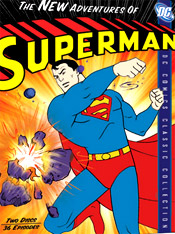
|
|||||||||
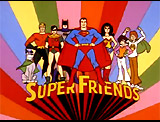
|
Super Friends (1973-1985) TV series Superman subsequently appeared in ABC-TV's long-running animated series Super Friends (1973-1985), produced by Hanna-Barbera, whose rights to DC Comics characters were gradually transferred from Filmation. Super Friends was the umbrella title under which a number of incarnations of DC superheroes cartoons aired from 1973 to 1985, based on the DC Comics concept of the Justice League of America (called Super Friends). It was part of a very popular Saturday morning cartoon lineup. The core group of characters central to the spirit of comic book heroism included Superman, Batman, Robin, Aquaman and Wonder Woman. Danny Dark was the voice of Superman/Clark Kent (Seasons 1-6). There were various iterations of the TV show, in six official seasons, and 109 episodes. Although there were six seasons, there was an additional 3 sets of shorts that ran from 1980-1983. In 1985, the Super Friends changed its title to The Super Powers Team: Galactic Guardians. The final episode, The Death of Superman, was aired on November 6th, 1985:
|
||||||||||
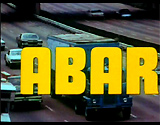
|
Abar, the First Black Superman (1977) (aka In Your Face) An R-rated blaxploitation film (90 minutes in length), directed by Frank Packard. Except for the title, the film had no relation to the super-hero "Superman" films of its time. Black Front of Unity (BFU) leader John Abar (Toblar Mayo), a young urban revolutionary, was transformed into an indestructible super human hero, with a serum developed by brilliant African-American scientist Dr. Kenneth Kincade (J. Walter Smith). The wealthy doctor wanted to protect himself from threats of extreme prejudice and racism after moving into a rich white neighborhood. |
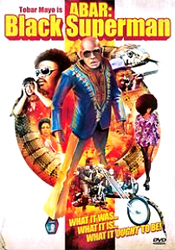
|
|||||||||
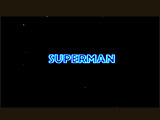
|
Four Superman Movies (1978-1987) The first major, big-budget superhero Superman feature film was director Richard Donner's blockbuster. It kept the basics of the Superman legend, while adding a love interest for the Man of Steel. Christopher Reeve starred as the superhero (and meek and bumbling alter-ego Clark Kent), who could be weakened by greenish Kryptonite. He was in love with fellow reporter Lois Lane (Margo Kidder), and was opposed to the villainy of Lex Luthor (Gene Hackman) and General Zod (Terence Stamp). The plot scheme of blowing up the San Andreas Fault with a nuclear device, to flood California and send it into the ocean, was also the premise of the 14th Bond film A View to a Kill (1985). This was the first of four epic, superhero films featuring comic-book hero Superman derived from the 1938 Action Comics character - not counting the latest film remakes. It was followed by three sequels - Superman II (1980), Superman III (1983) and Superman IV: The Quest for Peace (1987). The first two films were box-office successes, but Superman was not the most popular hero in the comic book world. Director Richard Donner filmed both Superman (1978) and Superman II (1980) simultaneously, when Richard Lester was called upon to replace Donner and finish the second film. |

|
|||||||||

|
Director Richard Lester's great sequel,, again with Christopher Reeve, Gene Hackman, and Margo Kidder, featuring Superman's struggle against three evil Kryptonians (one of whom was Terence Stamp as the diabolical Zod). Director Richard Donner who directed the original film was replaced by Richard Lester for the sequel, amidst controversy between Donner and the producers Alexander and Ilya Salkind. Superman II combined director Richard Donner's 1977 footage with Richard Lester's 1979 footage. Approximately 25-30% of Lester's Superman II was Donner's footage. |
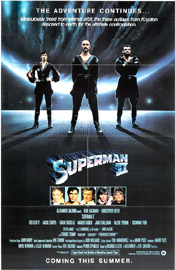
|
|||||||||
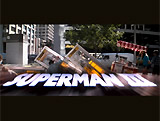
|
Director Richard Lester's inferior second sequel, with Christopher Reeve in his third Superman film. Although a profitable film in terms of box-office, it was unpopular with fans and critically assailed by reviewers for its slapstickish, overbearing comedic tone, rather than for following the initial film's tone of epic-adventure. Margot Kidder's role was reduced to a cameo, basically, with only about 5 minutes of screen time (in the film's opening office scene) and only 12 spoken lines of short dialogue. She also appeared briefly in the final scene, with a few more lines. |
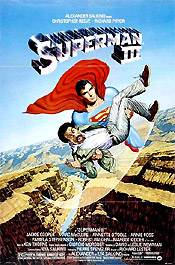
|
|||||||||
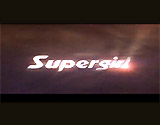
|
Supergirl (1984) Inserted into the original Superman franchise was the disastrous flop Supergirl (1984), with Helen Slater as the super-heroine cousin of Superman, a spin-off of the 1978 Superman film. |

|
|||||||||
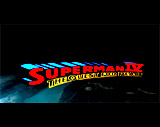
|
Superman IV: The Quest for Peace (1987) Featuring Christopher Reeve's fourth consecutive - and final appearance. Directed by Sidney J. Furie. Reeve also provided input for the co-authored story - an unabashed message of nuclear power and disarmament, and anti-corporate takeovers. This was the third film with Hackman's villain Lex Luthor. And it was the second film with a super-villain (the other was Superman II (1980)). The Salkinds produced the first three Superman films, and then sold the rights to Cannon/Golan Globus Productions who released the fourth film - the least popular film in the series and a major flop. After a disastrous preview screening and its theatrical release, the original film's length (134 minutes) was reduced to 90 minutes, leaving many plot points hanging, and others only unoriginal rehashes of former films. Its stripped budget resulted in cheap-looking special effects. |

|
|||||||||
Superman's 50th Birthday - 1988 Superman's 50th birthday in 1988 made the cover of Time Magazine. |
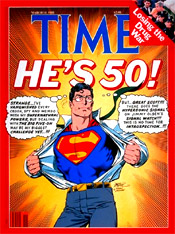
|
||||||||||
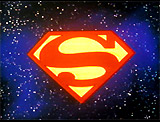 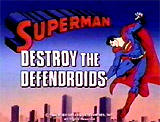
|
Superman (1988) - TV series Coinciding with Superman's 50th anniversary, Ruby-Spears Enterprises produced a Superman cartoon show. CBS-TV brought back Superman to its animated Saturday morning line-up. Superman was a half-hour show with each show having one 18 minute Superman adventure, and one four minute segment - a continuing series called Superman Family Album that chronicled Clark Kent's life between his actual adoption by Ma and Pa Kent and his public debut as Superman. It marked the third animated Superman series. It showed evidence of adaptations of the Superman saga that took into account major revisions and revampings to the character by comic book artist/writer John Byrne in his 1986 re-launch of the DC Comics’ Superman franchise. It ran for one season, and was composed of 13 30-minute episodes, broadcast from September 17 to December 10, 1988. Beau Weaver was the voice of Superman. The episode titles below are followed by the title of the Superman Family Album segment (in parentheses).
|
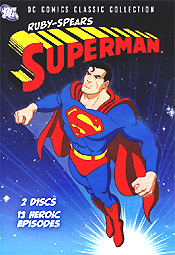
|
|||||||||
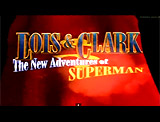
|
Lois & Clark: The New Adventures of Superman (1993-1997) - TV series A popular live-action TV series based on the characters in Superman and DC Action comics, based upon the characters created by Jerry Siegel and Joe Shuster. Dean Cain starred as Clark Kent/Kal El/Superman, and Teri Hatcher starred as Lois Lane. John Shea portrayed major villain Lex Luthor in season one. The hour-long ABC-TV show aired for four seasons from September 12, 1993 to June 14, 1997, for a total of 87 episodes.
|
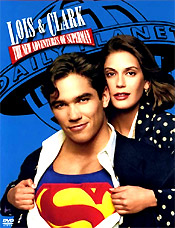
|
|||||||||
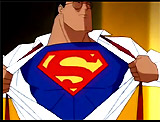 Superman: The Animated Series 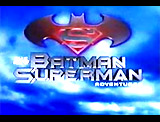 The New Batman-Superman Adventures |
Superman: The Animated Series (1996-2000) - TV series This animated series, titled Superman: The Animated Series, was broadcast on the WB-TV network from September 6, 1996 – February 12, 2000 (three seasons). It was the first of several spin-offs of the acclaimed Batman: The Animated Series (1992-1995), and considered its animated counterpart/equivalent. Each of the half-hour shows had a running time of 21 minutes for each episode. There were a total of 54 episodes.
Superman: The Animated Series (1996-2000) was combined or merged with The New Batman Adventures (1997-1999) show (produced by WB) to produce a new hour-long show, called The New Batman-Superman Adventures (1997-2000). The WB network aired the show on both Saturday mornings and weekday afternoons.
Each half-hour episode in the time slot featured either a single repeat from the original Superman: The Animated Series run, a repeat from the original Batman: The Animated Series run, or a brand new story featuring Batman made specifically for this series, drawn in an animation style to match Superman: The Animated Series. |
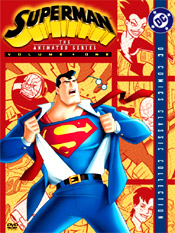
|
|||||||||
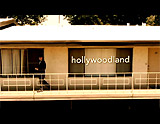
|
Hollywoodland (2006) This biopic docudrama told about the investigation of Superman-actor George Reeves' (portrayed by Ben Affleck) death at the age of 45, on June 16, 1959. The question remained: Did he commit suicide, or was he murdered? There were flashbacks to the actor's life, including Reeves' involvement in the filming of the immensely popular TV series Adventures of Superman (1952-1958). |

|
|||||||||
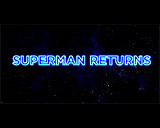
|
Directed by Bryan Singer. It was the fifth full-length feature film in the Superman series since 1978, starring newcomer Brandon Routh as the Man of Steel, and Kevin Spacey as Lex Luthor, Kate Bosworth as Lois Lane, Frank Langella as Perry White and Eva Marie Saint as Martha Kent. The underperforming film failed to really re-energize the franchise. It was the world's first live-action Hollywood feature with selected sequences (about 20 minutes) converted from 2D to IMAX 3D. The film was an unusual sequel in that it took place after the events of Superman II (1980), and pretended the events of the dismal next two sequels never took place. In the plot, Superman - after returning to Earth after five years in space - found that Lois Lane was a single mother and Lex Luthor was still causing trouble. It stressed its place in the series by the following:
|

|
|||||||||
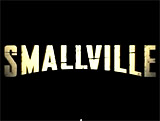 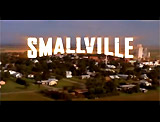 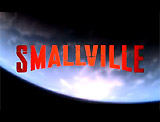
|
Smallville (2001-2011) - TV series This long-running, live-action TV series, a modern retelling of the Superman mythology, was initially broadcast on the WB network on Tuesday, October 16, 2001. After a merger of the WB and UPN after the show's 5th season in 2006, the show was broadcast on the CW network, until May 13, 2011. Tom Welling portrayed Superman/Clark Kent. Superman's two love interests were Lana Lang (Kristin Kreuk), and Lois Lane (Erica Durance), while the villain was Lex Luthor (Michael Rosenbaum). It became the longest-running North American science-fiction series and the longest-running comic-book-based series in TV history. The hour-long show (with 42 running time segments) was on the air for ten seasons, from 2001 to 2011. There was a total of 218 episodes:
|
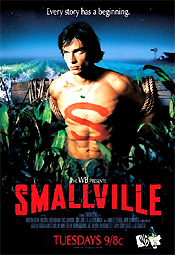 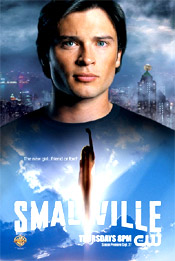
|
|||||||||
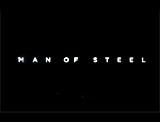
|
Man of Steel (2013) The next feature film, Man of Steel (2013), was a reboot of the series on the 75th anniversary of the character. This was the first film in the DC Extended Universe. It was directed by Zack Snyder and starred Henry Cavill as The Man of Steel, Russell Crowe as Superman's father Jor-El, Michael Shannon as General Zod on Krypton, the Kent parents (Kevin Costner and Diane Lane), and Amy Adams as Pulitzer Prize-winning reporter Lois Lane. |

|
|||||||||
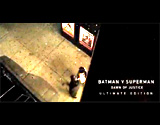
|
Batman v Superman: Dawn of Justice (2016) This special-effects laden superhero action film, Batman v Superman: Dawn of Justice (2016), directed by Zack Snyder, starred Ben Affleck as Batman, Henry Cavill as Superman, and Gal Gadot as Wonder Woman (in her first live-action screen appearance). Also Jesse Eisenberg portrayed Superman's long-time nemesis - the bald, smart villain Lex Luthor. Chronologically, this was the second film in the DC Extended Universe. |
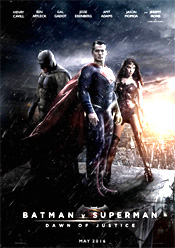
|
|||||||||